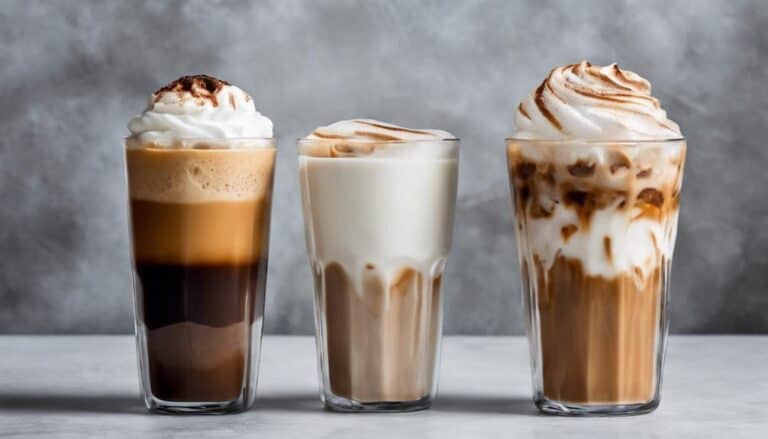Cappuccino Caffeine vs Coffee: Comparing Their Energizing Effects

When we dive into the world of caffeinated beverages, understanding the differences between cappuccino and coffee, especially in terms of caffeine content, is essential. Cappuccinos are a beloved coffeehouse staple known for their rich flavor, characterized by a perfect balance of espresso, steamed milk, and foam. On the other hand, standard brewed coffee is a straightforward drink made by filtering hot water through ground coffee beans, offering a robust and direct taste.

The caffeine content plays a pivotal role in our choice between these two options, affecting not just the energy boost we receive but also the flavor profile. Cappuccinos typically contain less caffeine, because they include a single shot of espresso, which is mingled with larger quantities of milk. In contrast, a regular cup of coffee provides a more substantial caffeine kick, as it comprises a more significant volume of just brewed coffee.
Additionally, the flavors and tasting notes we experience between a cappuccino and brewed coffee are distinctly different due to their preparation methods. The creamy texture and mild coffee flavor in cappuccinos offer a less intense taste, often preferred by those who enjoy a subtler coffee experience. Brewed coffee delivers a more powerful flavor, often sharper and more pronounced, enjoyed by those who appreciate the pure, unadulterated essence of coffee.
Understanding Caffeine
In this section, we look at the essentials of caffeine and compare its content in cappuccino vs. coffee to make informed choices about our caffeine intake.
Caffeine Basics
Caffeine is a natural stimulant found in the leaves, seeds, or fruit of over 60 plants worldwide. Primarily, we encounter caffeine in our diet through beverages such as coffee, tea, and energy drinks. Upon consumption, caffeine acts on the central nervous system, which can lead to increased alertness and temporarily provide an energy boost. However, it’s important to note that excessive caffeine consumption can lead to side effects such as anxiety or restlessness.
Caffeine Content in Cappuccino vs. Coffee
When comparing cappuccino and coffee, it’s essential to understand that the key variable is the preparation method. A cappuccino is typically made up of equal parts espresso, steamed milk, and milk foam, while the term ‘coffee’ can refer to a range of brewing methods and ratios.
Here is a simple comparison of average caffeine content:
| Beverage | Caffeine Content (average) |
|---|---|
| Coffee | 95mg per 8-ounce cup¹ |
| Cappuccino | 75mg per single shot of espresso² |
It’s clear that a standard cup of coffee generally contains more caffeine than a single shot of espresso, which is the base for cappuccino; however, cappuccinos are often made with one or more shots of espresso, increasing the caffeine content accordingly. The exact amount of caffeine in coffee can vary greatly depending on factors such as the type of beans, the brewing time, and the temperature.
While people might choose a cappuccino for its creamy texture or coffee for its straightforward boldness, understanding the caffeine content is critical to managing caffeine intake responsibly.
¹ What Has More Caffeine: Coffee or Cappuccino?
² Does Cappuccino Have Caffeine? (& Comparing Cappuccino And Coffee …)
Comparing Cappuccino and Coffee
In our exploration of cappuccino versus coffee, we hone in on the specifics of flavor nuances, caffeine content, and preparation methods that distinguish these popular beverages.

Flavor Profiles
Cappuccinos are characterized by a balance between the bold flavors of espresso and the creamy texture of steamed milk. The resulting beverage has a richness that coffee, typically brewed with just water, lacks. With regular coffee, the taste can vary widely from bitter to mild, depending on the beans and brewing technique, but it does not possess the milky or creamy notes inherent to a cappuccino.
Caffeine Levels
The amount of caffeine in both beverages is contingent upon the espresso and coffee bean quantity. Cappuccinos, traditionally made with a single shot of espresso, have less caffeine compared to a standard 8-ounce cup of coffee. To put it succinctly, we find that a cappuccino contains about 64 milligrams of caffeine, while regular coffee might have between 95 to 200 milligrams, as detailed in a comparison by Busy Barista.
Preparation Differences
Our cappuccino boasts a single shot of espresso combined with equal parts of steamed milk and milk foam, often garnished with a dash of cocoa or cinnamon. In contrast, coffee preparation typically involves pouring hot water over ground coffee beans. While the cappuccino charms with its layered structure and rich texture, coffee appeals with its straightforward strength and variety of flavors that emerge from different beans and roasts.
Ingredients and Brewing Methods

In this section, we focus on the distinct components and techniques that differentiate cappuccinos from regular brewed coffee. We examine the role of milk in cappuccino, the selection of coffee beans and roasts, and the popular brewing methods employed.
Milk in Cappuccino
Cappuccino is defined by its luxurious layer of steamed and frothed milk. The milk introduces a creamy texture and sweetness which balances the intense flavor of the espresso. Typically, whole milk is used for that rich froth, but variations may include lower-fat options or non-dairy alternatives.
Coffee Beans and Roasts
The choice of coffee beans significantly influences the flavor of both cappuccino and brewed coffee. Arabica beans are prized for their smooth, nuanced flavors, while Robusta beans pack a punch with their stronger, more bitter taste. The roast level can also alter the coffee’s profile, ranging from a light, acidic note to a full-bodied smokiness in darker roasts. Cappuccinos typically use a darker roast to stand up to the sweetness of the milk.
Popular Brewing Techniques
Brewing methods for coffee may vary from the simple French press to the convenient drip coffee machine. These techniques extract different flavors, mouthfeels, and caffeine contents. Cappuccinos, on the other hand, rely on espresso as their base—a concentrated coffee brewed by forcing hot water through finely-ground coffee beans. The strength of a cappuccino is therefore related to the espresso’s boldness, though it’s generally perceived as less intense due to being balanced with milk.
Nutritional Values and Health Impacts

When we compare the nutritional values and health impacts of cappuccino and coffee, we look at factors like calorie content and nutrient composition. These aspects are significant as they influence not only energy intake but also contribute to the overall health benefits one might garner from these beverages.
Calorie Comparison
A cappuccino, composed of espresso shots, steamed milk, and milk foam, typically contains fewer calories than a regular cup of coffee that might have added sugar and cream. However, the calories in a cappuccino can increase dramatically if sugar, flavored syrups, or high-fat milk are used.
- Cappuccino: Ranges from about 60-80 calories for a small cup without added sugar.
- Coffee: Without additives, ranges from about 2-5 calories per 8-ounce cup.
Nutrient Composition
Both coffee and cappuccino offer various nutrients and health benefits, largely due to the presence of caffeine and antioxidants. The milk in cappuccino additionally provides protein, calcium, and vitamins like Vitamin D if fortified.
Coffee:
- Antioxidants: Contains compounds such as chlorogenic acid which may help reduce inflammation and protect against disease.
- Vitamins & Minerals: Offers small amounts of B vitamins and potassium.
Cappuccino:
- Protein & Calcium: Thanks to the milk content, it provides a good source of protein and calcium which are essential for bone health.
- Fat: The fat content will vary depending on the type of milk used. Skim milk will have less fat, while whole milk will increase the fat content.
In terms of health benefits, both beverages have been associated with a reduced risk of certain diseases when consumed in moderation. However, we should be mindful of the additional calories and sugars that can be introduced by various additives.
Cappuccino and Coffee in Different Cultures
In exploring cappuccinos and coffee, we find a rich tapestry of cultural traditions that influence everything from serving size to the flavorings added. We’ll examine how the global consumption patterns of these beverages reflect diverse cultural preferences and serving methods.
Global Consumption Patterns
Coffee holds a special place in global consumption, being a morning ritual in countries like the United States, where the preference is often for a larger volume, like the Americano or a simple brewed coffee. On the other side of the spectrum, Italians revere the espresso shot as the foundation of their coffee culture, often enjoyed in a smaller serving size at a local cafe.
- United States: Preference for large volumes leading to popularization of drinks like Americano.
- Italy: Smaller, potent espressos dominate, serving as the base for macchiatos and cappuccinos.
As for cappuccino, specifically, it is popular in Europe, especially Italy, and is traditionally consumed in a specific size that balances the strength of espresso with the creaminess of foamed milk.
Cultural Variations in Serving
When it comes to serving, cultural nuances dictate how coffee and cappuccinos are presented. In Italy, a cappuccino is typically a morning beverage, never ordered past 11 AM, whereas in other places, the time of day is less significant. The Italian cappuccino is carefully crafted with equal parts espresso, steamed milk, and milk foam, served in a warm cup.
- Italy: Cappuccino ratio — 1/3 espresso, 1/3 steamed milk, 1/3 milk foam.
Austrian coffee houses, on the other hand, may offer a variety of traditional flavors from chocolate to whipped cream accompanying their coffees, showing a flair of elegance in both flavoring and volume. Meanwhile, regions in the Middle East may prefer their coffee with added spices, and the serving size becomes part of a social ritual where personal preference plays a significant role.
- Austria: Range of flavoring options, often elegant and rich in volume.
- Middle East: Spiced coffee served as part of a social custom, catering to personal preference.
In every culture, the way we serve and enjoy cappuccinos and coffee reflects our customs, personal tastes, and social habits.
Customizing Your Drink
When we consider customizing our cappuccinos or regular coffee, we think about adjusting flavors, milk proportions, and the strength of the brew to suit our personal tastes.
Flavor Additions and Substitutions
To enhance the flavor profile of our coffee or cappuccino, we often turn to various additions. We can incorporate sugar to add sweetness, or use alternatives like honey or stevia for different sweet notes. For those who prefer richer tastes, syrups such as vanilla, caramel, or hazelnut offer a delightful twist. And for a touch of spice, a dash of cinnamon or nutmeg blends well with the natural coffee flavors.
- Natural Sweeteners: Honey, Stevia
- Syrups: Vanilla, Caramel, Hazelnut
- Spices: Cinnamon, Nutmeg
Adjusting Milk and Foam Levels
The texture of our coffee drinks changes significantly with the alteration of milk and foam levels. A creamy cappuccino, traditionally made with equal parts of espresso, steamed milk, and frothed milk, can become even creamier with extra frothed milk. Meanwhile, if we prefer a stronger coffee taste with less creaminess, we can reduce the milk content in our black coffee or opt for an iced coffee with just a splash of milk.
- Creamy Texture: More frothed milk
- Less Creamy, Stronger Coffee Taste: Less milk or just a splash
Coffee Strength and Dilution
The strength of our coffee or cappuccino is determined by the ratio of water to coffee and the roast of the beans. A robust and bitter flavor often comes from a darker roast and less dilution. For those who enjoy milder beverages, a lighter roast or regular drip coffee diluted with more water or milk will do. We can also ask our barista to adjust the espresso shot volume in our beverages or experiment with recipes at home to find the perfect balance.
- Stronger, Bitter Flavor: Darker roast, less dilution
- Milder Flavor: Lighter roast, more dilution, more water or milk
By understanding these elements—flavoring, frothed milk, and coffee strength—we can customize our drinks to create the perfect cup that suits our individual preferences.
Decoding the Coffeehouse Experience
When venturing into a coffeehouse, we encounter a realm where the scent of freshly brewed coffee mingles with the sound of milk steaming. It’s essential to understand the roles played by baristas, the menu offerings, and the evolving trends as we decide between a creamy latte or an airy cappuccino.
Barista’s Role
Our experience at a cafe begins with a barista, the artisan responsible for crafting our coffee. Knowledgeable about all things coffee, baristas guide us through the options, ensuring whether we prefer a velvety cappuccino topped with perfectly foamed milk or a robust espresso, our choice is prepared to our liking.
Understanding Coffeehouse Menus
Navigating the coffeehouse menu can be as intricate as choosing a fine wine. Coffee sizes range from the dainty “short” to the substantial “venti,” a term we’ve grown accustomed to. We find that a latte’s milk content provides a creamy texture, while a cappuccino offers a more airy mouthfeel due to its higher foam ratio. For those who favor less caffeine, decaf options ensure enjoyment without the buzz.
Trends in Coffee and Cappuccino Consumption
Our coffee preferences often reflect current trends. Once the domain of black coffee or simple espresso, today’s coffeehouse scene includes a myriad of choices, each with their unique characteristics such as whole milk or dairy-free alternatives. Personal preference plays a significant role in whether we lean towards a traditional cappuccino with its elegant simplicity or the customizable options that latte art allows.
Environmental and Economic Considerations
As we examine the coffee and cappuccino industry, it’s important to consider both the environmental and economic aspects. Sustainable practices and their economic implications are closely interconnected, influencing everything from the soil where coffee is grown to the sales of our beloved cappuccinos.
Coffee Production and Sustainability
Coffee production has considerable environmental effects. Coffee plants require specific climatic conditions, primarily found in the equatorial regions known as the “Bean Belt.” The process of growing coffee, especially when not managed sustainably, can lead to deforestation and loss of biodiversity. This impacts the color and composition of entire ecosystems. Additionally, coffee grounds, a byproduct of brewing, often end up in landfills, contributing to methane emissions.
To reduce these impacts, methods such as shade-grown coffee can preserve natural habitats and maintain soil quality. Furthermore, the use of coffee grounds for composting or as a natural fertilizer is an example of a circular approach to the coffee waste problem.
Economic Impact of Coffee and Cappuccino Sales
The global coffee industry is massive, often cited as the second most traded commodity after oil. This industry provides an energy boost not only to consumers but also to economies, with millions of people worldwide dependent on coffee production for their livelihoods. In terms of sales, cappuccinos represent a significant portion of the market, offering higher profit margins than regular drip coffee due to their milk content and artisanal presentation.
However, economic disparities persist in coffee-producing countries. Despite the high price of cappuccinos in consumer countries, farmers often receive only a fraction of the retail value. Various certifications, like Fair Trade, aim to improve these economic terms, assuring consumers that farmers are receiving a fairer portion of the earnings.
We understand the intricate balance between sustaining the environment and boosting the economy. Through conscious consumer choices and industry-wide shifts towards sustainability, we can support both the planet and the livelihoods of those in the coffee sector.
Conclusion
When we compare cappuccino versus coffee, it’s clear that the two beverages offer distinct experiences, both in flavor and caffeine content. A cappuccino, crafted with equal parts espresso, steamed milk, and milk froth, provides a balance that leans towards a creamy and sweet profile. Regular coffee, typically prepared by brewing hot water with ground coffee beans, skews towards a straightforward and stronger taste.
Caffeine content is another factor that differentiates these two drinks. Espresso serves as the base for cappuccinos, and typically has a higher concentration of caffeine per ounce. However, because cappuccinos include milk and usually feature a single or double-shot of espresso, the total caffeine content can be lower than that of a regular coffee. This is supported by observations revealing that cappuccinos generally have less caffeine than regular coffee due to their milk component and the quantity of espresso used.
In terms of preparation, we find that regular coffee allows for various brewing methods, while a cappuccino requires the skills to steam and froth milk properly, alongside a quality espresso shot. The inclusion of flavoring or additional fats from milk can further distinguish these two in both taste and nutritional profile.
Here’s a quick overview to sum up the differences:
- Flavor: Cappuccinos are creamy and can be sweet, with a smooth texture. Coffee’s flavor is robust and direct.
- Caffeine Content: Cappuccinos often have less overall caffeine due to milk dilution; coffee’s caffeine levels can be higher.
- Preparation: Cappuccinos need an espresso machine for milk steaming and frothing; coffee can be prepared with various methods.
- Strength: Coffee may taste stronger due to less milk and a higher ratio of hot water to grounds compared to espresso in a cappuccino.
Understanding these factors helps us appreciate the unique qualities and appeal of each beverage, enabling us to make informed choices based on our personal preferences for flavor and caffeine.





